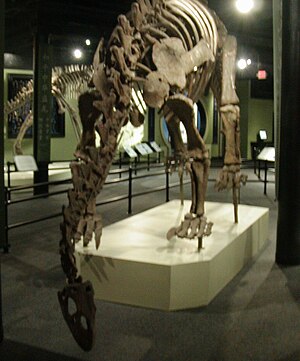Shunosaurus
| Shunosaurus | ||||||||||||
|---|---|---|---|---|---|---|---|---|---|---|---|---|

Skeletal reconstruction of Shunosaurus lii in the Beijing Museum of Natural History |
||||||||||||
| Temporal occurrence | ||||||||||||
| Middle Jurassic ( Bathonian to Callovian ) | ||||||||||||
| 168.3 to 163.5 million years | ||||||||||||
| Locations | ||||||||||||
| Systematics | ||||||||||||
|
||||||||||||
| Scientific name | ||||||||||||
| Shunosaurus | ||||||||||||
| Dong , Zhou & Zhang , 1983 | ||||||||||||
| species | ||||||||||||
|
Shunosaurus ( German : "Echse von Sichuan ") is the scientific name of a genus of sauropod dinosaur whose fossil remains come from the Middle Jurassic ( Bathonium to Callovium ) of today 's China . The term Shunosaurus comes from the word "Shu", which is an old name for the Chinese province of Sichuan, where the first fossils of a Shunosaurus were discovered. Shunosaurus shared its habitat with the other sauropods Datousaurus , Omeisaurus and Protognathosaurus as well as with the ornithopod Xiaosaurus , the early stegosaur Huayangosaurus and the carnivorous theropod Gasosaurus .
Discovery and species
Shunosaurus is known today for 20 complete or nearly complete fossil skeletons . Due to the numerous finds he is anatomically one of the best-known sauropods . Said fossils all come from the Lower Shaximiao Formation in Zigong , Sichuan . The first scientific description of the type species Shunosaurus lii was in 1983 by Dong, Zhou and Zhang. A second species, however, Shunosaurus ziliujingensis, has never been scientifically described and is therefore considered a nomen dubium . Shunosaurus skeletons are now on display at the Zigong Dinosaur Museum and the Beijing Museum of Natural History.
Systematics
Shunosaurus is now considered a basal Eusauropod. A membership of the Cetiosauridae is rejected by most paleontologists today . Presumably he was related to Rhoetosaurus , whose fossils come from Queensland , Australia .
anatomy
At nine to ten meters in length and weighing three tons, Shunosaurus was quite small for a sauropod . Its skull was short and flat with sturdy teeth, which, unlike more highly developed sauropods, did not only sit in the front jaw.
In 1989 it was discovered that at the tail end of Shunosaurus there was a small "club" formed from fused caudal vertebrae and also studded with spines. It was very likely used to defend against predators.
Individual evidence
- ^ Gregory S. Paul : The Princeton Field Guide To Dinosaurs. Princeton University Press, Princeton NJ et al. 2010, ISBN 978-0-691-13720-9 , pp. 173-175, online .
- ^ Dougal Dixon : The World Encyclopedia of Dinosaurs & Prehistoric Creatures. Lorenz Books, London 2007, ISBN 978-0-7548-1730-7 , p. 186.